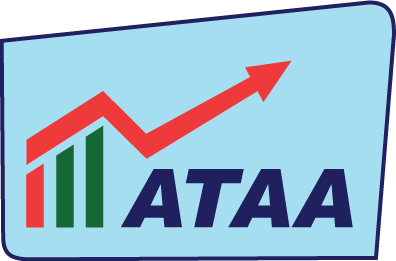Technical Analysis - a definition
"The interpretation of past share prices
(mostly on share price charts)
to try to gauge likely future price action."
Reading tea leaves?
Some people might think that this is just as good as
reading tea leaves. But, there is some very uncanny success in
what the charts can tell us because they summarise the opinions of
the real market participants.
Take a look at the analysis of recent bull markets and bear markets, and how technical analysis
gave us lots of warnings before they hit.
TA - Why use it?
Technical analysis is a very useful collection of tools to help
understand the sentiment that is driving share prices, in
anticipation of having a better feel for where share prices might
move in the future.
What is Technical Analysis (TA)?
(I will use the acronym TA to abbreviate Technical Analysis here
only for convenience and to help with readability and
comprehension.)
TA is to do with analysing the various financial markets, to help
anticipate likely financial performance. (But it is not 100%
accurate.)
An alternative way to analyse the markets is to use Fundamental Analysis. At the one extreme
some people will use pure TA for 100% of their analysis, and
others will use 100% Fundamental Analysis. Then there are
many people who will utilise a combination of both. Having said
that, I won't refer to Fundamental Analysis on this page again.
So, what about just TA?
TA is a very broad field, but is basically the analysis of past
"prices" in the hope of forecasting or anticipating future price
changes.
For a list of various definitions, see the Google search engine.
What "prices" are we talking about?
The reference to "prices" is a reference to a whole lot of things to
which we can apply the study of TA, including the following
financial instruments:
- stocks, equities, shares
- foreign currencies
- tradeable share Options and Warrants
- CFDs (Contracts for Difference)
- Commodities (eg. oil, gold, pork bellies, etc.)
How do we do this?
We implement TA techniques using price charts of the financial
instrument in question.
The best way to do this is to use a quality share price charting
tool (computer software), coupled with a reliable and quality data
source. Or for those more experienced and knowledgeable, use the
computer-based quantitative analysis.
Robert's charting tool of choice is the Australian BullCharts software package. |
The field of
Technical Analysis comprises:
The very broad field of TA comprises a number of sub-topics. Some
people prefer to follow a limited number of these sub-topics. To be
a competent technical analyst there is no requirement to be
competent in all of the following. Just a couple might be
enough.
Much of technical analysis is actually based on the teachings and
theories of Dow Theory.
Primary Analysis
- Various price chart types (candlestick,
Point and Figure, Gann Swing, Renko, etc.)
- Trends and trend lines
- Support and
resistance
- Volume (it's important)
- Chart patterns
(eg. triangles, pennants, flags, wedges, head and shoulders,
double top, etc.)
- Candlestick
chart basics
- Candle patterns (eg. doji, hanging man, hammer, engulfing,
harami, piercing, etc.)
Secondary Analysis
Various indicator types:-
Trend, Volatility, Momentum, Volume
Note: some of the items listed below are described in more detail
in the eBook (PDF)
Articles.
- Trend indicators:
- Moving Average
- Multiple Moving Average (MMA)
- MACD
- Parabolic-SAR
- ADX / DMI
- Volatility indicators:
- Bollinger Bands
- ATR (Average True Range)
- Envelopes
- Momentum indicators:
- Momentum
- Twiggs Money Flow
- OBV (On Balance Volume)
- A/D (Accumulation / Distribution)
- Price Rate of Change (ROC)
- RSI (Relative Strength Index)
- Stochastic
- CCI (Commodity Channel Index)
- Coppock
- Volume indicators:
- Volume with MA of volume
- Volume Rate of Change
- Volume Oscillator
Additional Topics:
- Quantitative analysis and computational techniques.
- Cycle analysis
- Fibonacci number sequence (0, 1, 2, 3, 5, 8, 13, 21, 34, 55,
89, 144, 233....)
- Elliott Wave
- W.D.Gann
|
How to learn more
about technical analysis?
Technical
Analysis - Getting Started - Robert's suggested steps on how
to make progress with learning about Technical Analysis.
More information
 Funda-Technical Analysis - An investment
and trading approach utilising a sensible balance of both Technical
Analysis and Fundamental
Analysis. Funda-Technical Analysis - An investment
and trading approach utilising a sensible balance of both Technical
Analysis and Fundamental
Analysis.
 Brainy's
3Ways
Rule - a smart way to understand trends, and the
importance of spotting trends. Brainy's
3Ways
Rule - a smart way to understand trends, and the
importance of spotting trends.
Brainy's extensive list of eBook (PDF) Articles
on Technical Analysis and other topics.
Brainy's seminars on Technical Analysis and other topics
- click
here for details...
A variety of publications on Technical Analysis and related
topics - click here
for details...
ATAA
Australian Technical Analysts Association
 The ATAA is Australia's
pre-eminent not-for-profit organisation regarding technical
analysis. The ATAA is Australia's
pre-eminent not-for-profit organisation regarding technical
analysis.
Some of the experienced ATAA members have contributed to regular
articles in The Age and Sydney Morning Herald newspapers.
Scanned copies of these articles
are available for perusal.
Robert is a member of the Australian
Technical Analysts Association (ATAA). He is (since 2009) also
the Melbourne Chapter Vice-President, and a former director on the
national board (2009 to 2020). Robert endorses the ATAA as a worthy
not-for-profit association for people looking for education, help
and networking.
See more information
about the ATAA.
And whatever you do,
beware of the sharks in the ocean!
|


